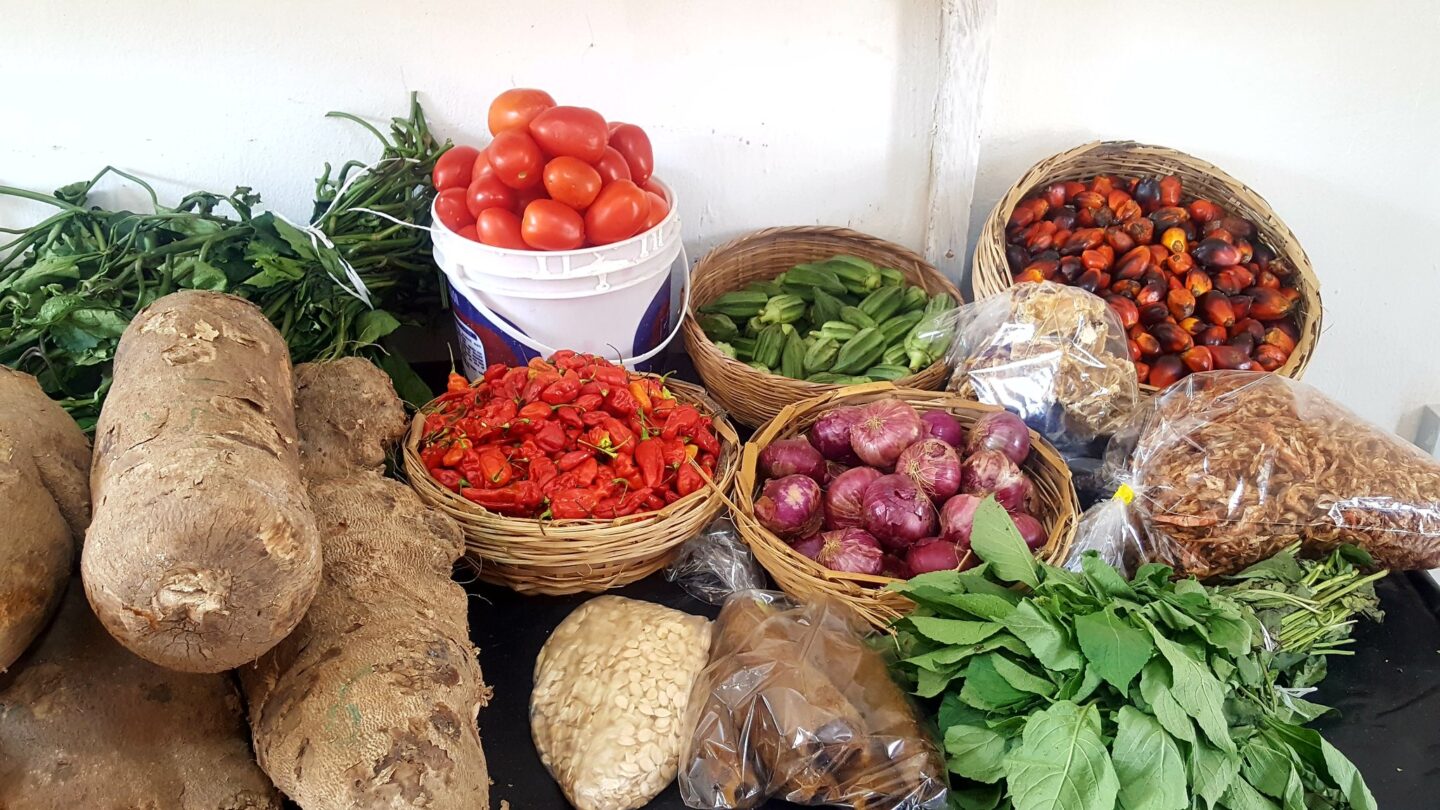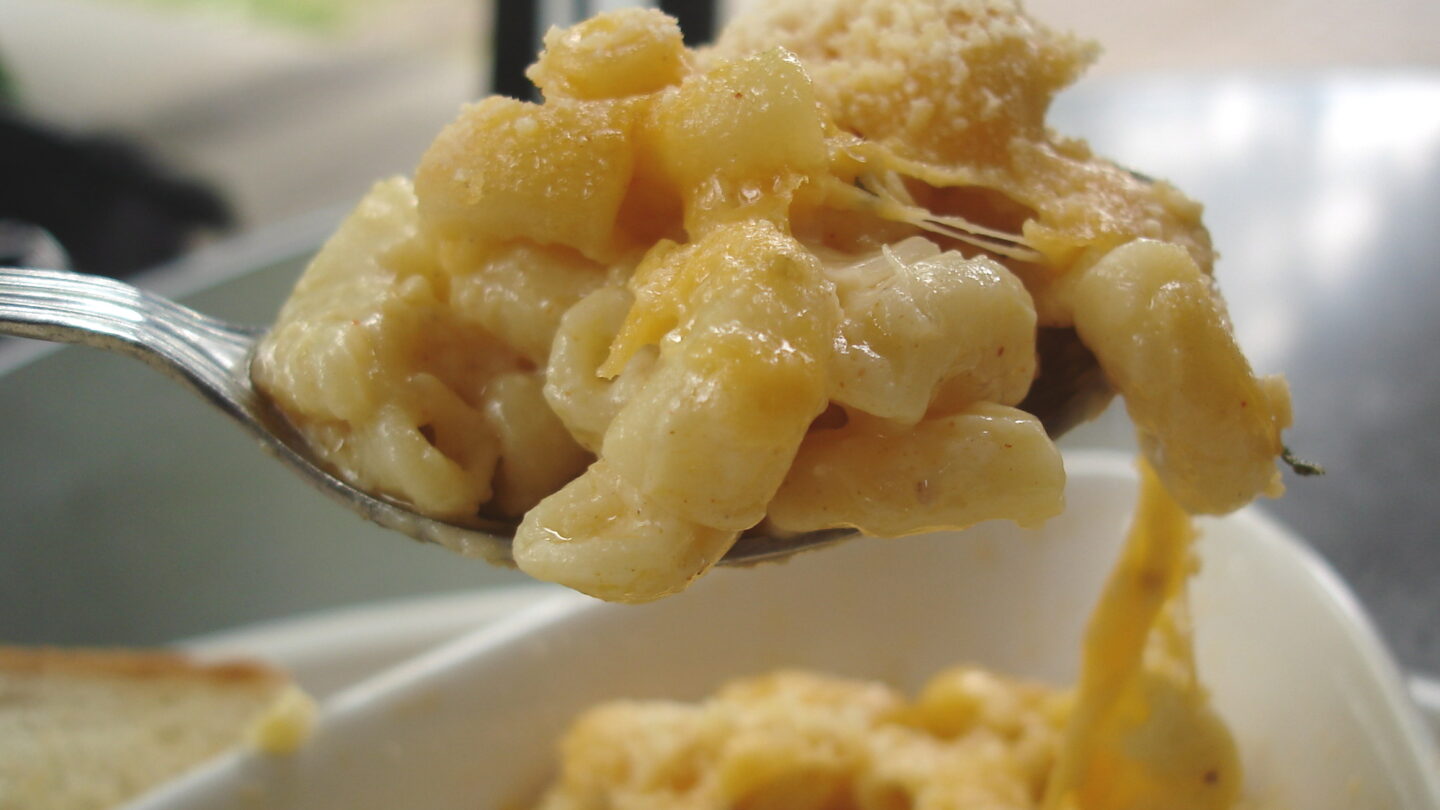
Traditional West African foods such as yams, tomatoes, onions, melons, pepper, pumpkin leaves, okra, palm kernel, crayfish, and stockfish. Bukky658, Wikimedia Commons
From steaming plates of savory red beans and rice to cake stands overflowing with decadent sweets, foods shape our culinary world and are woven into our culture, traditions, and histories. Beyond the meals themselves, stories of the creators and innovators behind these recipes often stand out as the most memorable part of our culinary experiences.
In the United States, generations of African Americans have established and maintained Foodways rooted in the Black community. However, while these recipes may grace our dinner tables, their origins are often underrepresented or forgotten. Journey through this article to uncover the beginnings of African American cuisine by exploring three cherished foods within the Black community. Learn how they changed the culinary landscape in America, nourishing our nation for centuries.
A Marchande des Calas (Calas vendor), 1886, Century Magazine
Retaining Cuisine
Our story begins in Africa, where thriving fields, vines, and pods overflow with African rice, okra, watermelon, yams, African eggplant, and cowpeas. For centuries, these crops formed the foundation of African cuisine, cultivated by farmers who adapted to harsh growing conditions, chefs who reimagined spice combinations, and families who passed down their knowledge through generations. However, this rich legacy cannot be told without acknowledging the tragic history of the enslavement of African people.
The year 1619 is often marked as the beginning of American slavery. However, almost 200 years earlier, Portugal established the European transatlantic slave trade. This buying and selling of African men, women, and children severed a natural relationship between the land and its people. In response, many enslaved Africans preserved their food culture as a form of resistance and survival, ensuring that many dishes offering comfort and connection still grace our tables today.
Calas (ka-la) are a delectable example of fare that survives today and can be traced back to Africa. These rice fritters are fried until golden brown and dusted with powdered sugar. When African people were taken from their homelands, their knowledge of rice cultivation went with them. Upon arriving in places such as Louisiana, this expertise with rice enabled enslavers to cultivate and sell the crop, profoundly influencing the diets of people in the colony and, later, the state.
What made calas’ origin unique was their connection to the Code Noir. Created and implemented in French colonial Louisiana, the Code Noir outlined guidelines for the treatment of enslaved and free people of African descent. Although the Code Noir was officially abolished by 1848, its influence continued to heavily regulate the lives of enslaved people.
One article of the code—integral to our fritter story—prohibited enslavers from requiring enslaved people to work on Sundays and holidays. This “day of rest” allowed enslaved African American women to participate in street vending, leading to the emergence of cala women.
Typically depicted wearing tignons, flowing dresses, and white aprons, cala women were seen and heard throughout the French Quarter. With coal-heated braziers and baskets balanced atop their heads, each rice fritter they sold carried the legacy of West African food culture. Today, it is sometimes hard to find calas, but new efforts aim to ensure that their origin story, and the work of enslaved women who preserved their foodways, are not lost.

Before casserole dishes across the United States were filled with buttered noodles and covered in creamy cheddar cheese, macaroni and cheese could only be found in France. Vancouver Bites! Wikimedia Commons
Revolutionizing Cuisine
Enslaved African Americans continued to express agency through food outside of the Creole state. In addition to introducing West African dishes into white society, African Americans became chefs, recreating, popularizing, and ultimately embracing meals sought after by their enslavers.
One instance of this happened in the household of President Thomas Jefferson. An ardent Francophile, Jefferson deeply admired French architecture, traditions, and clothing. And French cuisine particularly captivated him while he served as the American minister to the French court. However, French chefs’ culinary artistry came at a high price. To circumvent this, Jefferson hired French chefs to train people he enslaved at his plantation, Monticello, in Virginia, including James Hemings, the brother of Sally Hemings.
Born in 1765 to his enslaver, John Wayles, and his enslaved mother, Elizabeth Hemings, James Hemings remained relatively unknown until 1773, when Wayles died. Hemings, along with his mother and siblings, was then inherited by his half-sister Martha Wayles and her husband Thomas Jefferson.
During his adolescence at Monticello, Hemings and his brother Robert served as valets to Jefferson as the wartime governor of Virginia. In 1784, Hemings received his first exposure to French cuisine when he accompanied Jefferson and his daughter Martha to Paris. In Paris, Hemings trained as a French cook with caterer and restaurateur Monsieur Combeaux, apprenticed alongside pastry chefs in the household of the Prince de Condé, and became renowned for his elaborate dinners at Hôtel de Langeac, where he served as head chef.
By 1787, Hemings had returned to the United States. He was still enslaved by Jefferson, who tasked him with serving French recipes at Monticello, New York, Philadelphia, and the White House. Though largely unrecognized during his lifetime, the dishes he introduced—including French fries, ice cream, and, most notably, macaroni pie—altered the course of American culinary history.
Although James Hemings didn’t invent the mac and cheese recipe found at modern social gatherings, he revolutionized America’s association with the dish and used earnings from his culinary skills to buy his freedom in 1796. After he died, Hemings’ legacy continued to be served on dinner tables across the country. Today, he is acknowledged for helping popularize a recipe that is connected to and celebrated in Black culture.
Bean pie. Henderson Library, Georgia Southern University
Reimagining Cuisine
On June 19, 1865, the news of emancipation finally reached those enslaved in Galveston, Texas, when Union General Gordon Granger announced General Order No. 3, declaring all enslaved individuals free. Although many enslaved African Americans celebrated two years earlier when President Abraham Lincoln issued the Emancipation Proclamation—a decree that declared freedom for enslaved people in Confederate states—Texas, the westernmost Confederate-aligned state, continued to practice slavery. When Union troops arrived and enforced emancipation, the formerly enslaved celebrated. This observation became known as “Juneteenth.”
Juneteenth celebrations often included traditional foods, which were crucial in maintaining cultural heritage and fostering community bonds among African Americans. The meals African Americans used for survival and cultural retention remained steadfast in the community and played an important role in significant historical events, particularly during the struggle for Black self-determination.
One such dish with origins in Black empowerment is the humble bean pie. Introduced by the Nation of Islam in the 1930s, the bean pie was created as a healthier substitute for the commonly enjoyed sweet potato pie. Founded in Detroit in 1930 and undergirded by Islamic teachings, the NOI worked to uplift African Americans’ social, moral, and economic standing. During the 1950s and 1960s, the organization became a haven for some activists and leaders in the Civil Rights Movement. NOI mosques offered meals to civil rights protestors and opened grocery stores and restaurants in predominantly Black areas to promote economic well-being and food security. The integration of the NOI into Black neighborhoods led to the spread of the bean pie.
Unlike calas and macaroni pie, it’s unclear who created the bean pie recipe. Instead, the bean pie’s legacy is woven into the history of the NOI and civil rights, stretching far beyond Detroit to cities such as Atlanta, Chicago, and Los Angeles. In fact, Black Muslims still sell bean pies on the streets of major cities today.
View of an unidentified individual eating at Shepherd’s Restaurant on Butler Street. Boyd Lewis, Boyd Lewis Photographs, Kenan Research Center at Atlanta History Center
From the thriving fields of Africa to the vibrant streets of New Orleans, and from the innovative kitchens of Monticello to the activism-fueled gatherings of the Civil Rights Movement, African American cuisine has profoundly influenced the culinary landscape of America. Today, as you enjoy a steaming plate of macaroni and cheese or devour a slice of bean pie, recognize the labor and brilliance woven into these recipes.
Recipes
The legacy of African American cuisine is a testament to the enduring spirit and cultural richness that continue to shape our culinary world. Be a part of the legacy; try one of the recipes below in your own kitchen.
Ingredients
- 1/2 cup warm water
- 1 tbsp granulated sugar
- 1 pkg active dry yeast
- 3/4 cup cooked white ice
- 2 large eggs, beaten slightly
- 3/4 cup all-purpose flour
- 1 pinch kosher salt
- 1/4 tsp vanilla extract
- 1/8 tsp freshly grated nutmeg
- Peanut oil for frying
- Powdered sugar for a heavy dusting
Directions
The day before you want to make your calas, combine the water and sugar in a small bowl. Add the yeast and let stand until foamy, about 10 minutes. Add the rice and stir well. Cover with plastic wrap and leave at room temperature overnight. This step will really give your calas a distinctive flavor; think sourdough.
The next day, stir the rice mixture and kind of mash the rice against the side of the bowl with a wooden spoon. Don’t go too crazy though, I like to have a bit of that rice texture in the finished product.
Add the remaining ingredients to the rice mixture, mix well with a wooden spoon. The mixture should be a fairly loose batter, a little thicker than pancake batter. Cover and let rise in a warm place for 1 hour. This step will make your calas as light as air when fried.
Heat 3 inches of peanut oil in a large saucepan to 365 degrees. Drop spoonfuls of the calas batter into the hot oil. Fry until golden brown, turning once. Serve with lots and lots of powdered sugar, like beignets, or drizzle with cane syrup. Recipe makes about 6 good sized calas.
Source: NOLA Cuisine
Ingredients
- 4 cups whole milk
- 4 cups water
- 1 pound macaroni
- 6 tablespoons unsalted butter (cubed)
- 8 ounces grated extra sharp Cheddar
- Salt to taste
Directions
Preheat oven to 375 degrees. Stir together the milk and water in a large pot and bring to a boil. Add macaroni, stir well, and return to a boil. Reduce the heat and simmer, stirring occasionally, until the macaroni is tender (about 10 minutes for commercial pasta). Lightly drain it in a colander (it should still be wet) and return it to the pot. Season with salt to taste and toss well.
Lightly butter a 2-quart casserole dish and cover the bottom with one-third of the macaroni. Dot with one-third of the butter and one-third of the cheese. Repeat the layers twice more, finishing with a thick layer of cheese, and bake until golden brown, about 20 to 30 minutes.
Source: Monticello
Ingredients
- 2 cups navy beans (cooked according to package instructions)
- 1 stick butter
- 2 tablespoons flour
- 2 eggs
- 1/2 teaspoon nutmeg
- 2 cups sugar
- 1 ½ cup milk
- 1 teaspoon cinnamon
- 1 teaspoon vanilla
Directions
Preheat oven to 325 to 350 degrees. With an electric blender, blend beans, butter, milk, eggs, nutmeg and flour for about 2 minutes on medium speed. Pour mixture into a large mixing bowl. Add sugar and vanilla. Mix well. Pour into 9-inch pie shells. Bake for about one hour until golden brown. Makes 2 or 3 bean pies.
Source: Rhonda K. Muhammad

